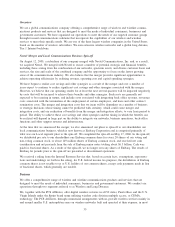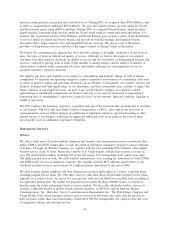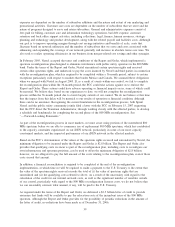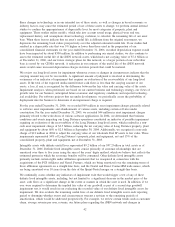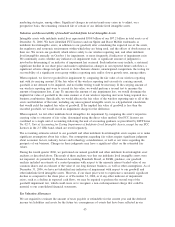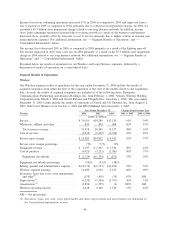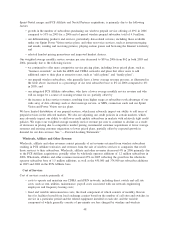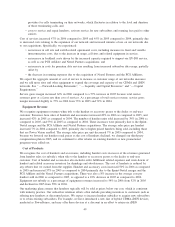Sprint - Nextel 2006 Annual Report Download - page 44
Download and view the complete annual report
Please find page 44 of the 2006 Sprint - Nextel annual report below. You can navigate through the pages in the report by either clicking on the pages listed below, or by using the keyword search tool below to find specific information within the annual report.Since changes in technology or in our intended use of these assets, as well as changes in broad economic or
industry factors, may cause the estimated period of use of these assets to change, we perform annual internal
studies to confirm the appropriateness of depreciable lives for most categories of property, plant and
equipment. These studies utilize models, which take into account actual usage, physical wear and tear,
replacement history, and assumptions about technology evolution, to calculate the remaining life of our asset
base. When these factors indicate that an asset’s useful life is different from the original assessment, we
depreciate the remaining book values prospectively over the adjusted estimated useful life. If our studies had
resulted in a depreciable rate that was 5% higher or lower than those used in the preparation of our
consolidated financial statements for the year ended December 31, 2006, recorded depreciation expense would
have been impacted by about $300 million. In addition to performing our annual studies, we also continue to
assess the estimated useful life of the iDEN network assets, which had a net carrying value of $7.4 billion as
of December 31, 2006, and our future strategic plans for this network, as a larger portion of our subscriber
base is served by our CDMA network. A reduction in our estimate of the useful life of the iDEN network
assets would cause increased depreciation charges in future periods that could be material.
We review our long-lived assets for impairment whenever events or changes in circumstances indicate that the
carrying amount may not be recoverable. A significant amount of judgment is involved in determining the
occurrence of an indicator of impairment that requires an evaluation of the recoverability of our long-lived
assets. If the total of the expected undiscounted future cash flows is less than the carrying amount of our
assets, a loss, if any, is recognized for the difference between the fair value and carrying value of the assets.
Impairment analyses, when performed, are based on our current business and technology strategy, our views of
growth rates for our business, anticipated future economic and regulatory conditions and expected technolog-
ical availability. For software projects that are under development, we periodically assess the probability of
deployment into the business to determine if an impairment charge is required.
For the year ended December 31, 2006, we recorded $69 million in asset impairment charges primarily related
to software asset impairments and abandonments of various assets, including certain cell sites under
construction. For the year ended December 31, 2005, we recorded $44 million in asset impairment charges
primarily related to the write-down of various software applications. In 2004, we determined that business
conditions and events impacting our Long Distance operations constituted an indicator of possible impairment
requiring an evaluation of the recoverability of the Long Distance long-lived assets, which resulted in a non-
cash asset impairment charge of $3.5 billion, reducing the net carrying value of Long Distance property, plant
and equipment by about 60% to $2.3 billion at September 30, 2004. Additionally, we recognized a non-cash
charge of $21 million in 2004 to adjust the carrying value of our wholesale Dial IP assets to fair value. These
impairments represented 54% of Long Distance’s property, plant and equipment, net and 13% of the
consolidated property, plant and equipment, net at December 31, 2003.
Intangible assets with definite useful lives represented $9.2 billion of our $97.2 billion in total assets as of
December 31, 2006. Definite lived intangible assets consist primarily of customer relationships that are
amortized over three to five years using the sum of the years’ digits method, which we believe best reflects the
estimated pattern in which the economic benefits will be consumed. Other definite lived intangible assets
primarily include certain rights under affiliation agreements that we reacquired in connection with the
acquisitions of the PCS Affiliates and Nextel Partners, which are being amortized over the remaining terms of
those affiliation agreements on a straight-line basis, and the Nextel and Direct ConnectSM trade names, which
are being amortized over 10 years from the date of the Sprint-Nextel merger on a straight-line basis.
We continually assess whether any indicators of impairment exist that would trigger a test of any of these
definite lived intangible assets, including, but not limited to, a significant decrease in the market price of the
asset, cash flows or a significant change in the extent or manner in which the asset is used. In addition, if we
ever were required to determine the implied fair value of our goodwill as part of a second step goodwill
impairment test, it would result in our evaluating the recorded value of our definite lived intangible assets for
impairment. We also evaluate the remaining useful lives of our definite lived intangible assets each reporting
period to determine whether events and circumstances warrant a revision to the remaining periods of
amortization, which would be addressed prospectively. For example, we review certain trends such as customer
churn, average revenue per user, revenue, our future plans regarding the iDEN network and changes in
42





